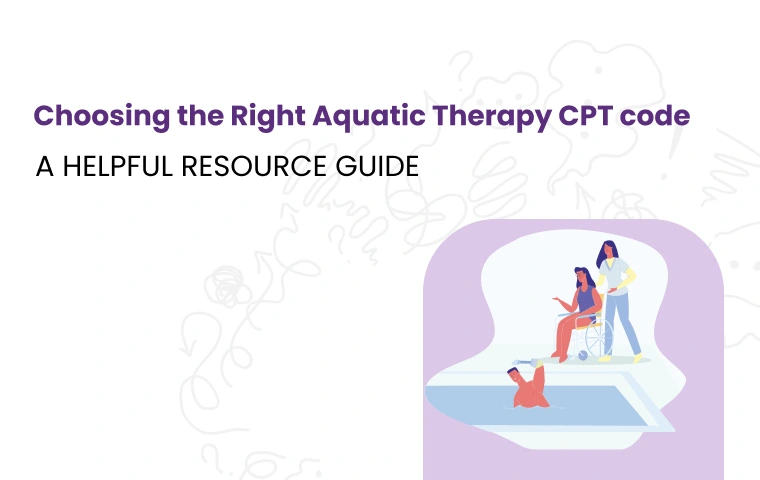Aquatic therapy's rising popularity as a potent treatment modality is undeniable. However, its relative novelty often hurdles the billing process, leaving many providers grappling with selecting appropriate CPT codes. This comprehensive guide aims to dispel the confusion, providing clear-cut knowledge about the relevant codes and guidelines you need to confidently and accurately bill for aquatic therapy procedures.
CPT Code for Aquatic Therapy
The primary CPT code used for billing aquatic therapy or hydrotherapy is 97113. American Medical Association defines this as a Therapeutic procedure, 1 or more areas, each 15 minutes; aquatic therapy with therapeutic exercises.
This code encompasses the therapeutic exercises performed in an aquatic environment, utilizing the unique properties of water for rehabilitation and treatment.
Key points to remember
97113 is a timed code, meaning it's billed in 15-minute increments. Each unit represents 15 minutes of direct, one-on-one patient care provided by a qualified healthcare professional.
[Also See 8 - Minute Rule Therapy Guide]
The code specifically includes therapeutic exercises, which may involve strengthening, range of motion, balance training, gait training, and pain management techniques, all performed within the aquatic environment.
Documentation Guidelines for Aquatic Therapy
Thorough and meticulous documentation is paramount to justifying the medical necessity of aquatic therapy and securing appropriate reimbursement.
Clearly articulate why the aquatic environment is essential for the patient's treatment plan. Highlight the specific benefits of water, such as buoyancy, resistance, or hydrostatic pressure, and how they address the patient's unique needs and limitations.
Document specific and measurable deficits in activities of daily living (ADLs), mobility, range of motion (ROM), strength, balance, coordination, or posture. Clearly link these impairments to the patient's underlying condition and explain how they impact their overall function.
If pain is a factor, include detailed information about the pain rating, location, and its impact on the patient's function. This helps justify the need for aquatic therapy as a pain management modality.
Provide a comprehensive account of the specific exercises or activities performed during each session. Include information about the purpose of each exercise, the level of progression or modification, any instructions or cues provided, and the level of assistance required. This demonstrates the skilled nature of the therapy and the active involvement of the qualified professional.
Additional Considerations
Frequency and Duration: Document the frequency and duration of each aquatic therapy session, including the total treatment time and the actual time spent performing skilled exercises. This information is crucial for accurate billing using the timed CPT code 97113.
Progress Notes: Regularly document the patient's progress towards their treatment goals. Highlight any improvements in function, pain reduction, or other positive outcomes. This helps justify the continued need for aquatic therapy and demonstrates its effectiveness.
Supportive Documentation: Every 10 visits, include additional documentation to support the medical necessity of aquatic therapy further. This may include updated functional assessments, pain scales, or progress reports.
Coding Guidelines for Aquatic Therapy
CMS explicitly states that aquatic therapy services will not be reimbursed if therapeutic exercises are not performed in the water environment. Merely supervising or instructing patients while they are in the pool does not qualify for billing under CPT code 97113.
Example: If a therapist spends time educating the patient about water safety or pool rules, this time cannot be included in the billable units for aquatic therapy. However, if the therapist is actively guiding the patient through exercises in the water, this time is billable.
When multiple patients require the aquatic environment for therapy, CMS allows for group therapy billing under cpt code 97150 under certain conditions. However, direct one-on-one patient contact by the therapist or qualified auxiliary personnel is still required for each patient during the billable treatment time.
Example: If a therapist works with three patients simultaneously in the pool, providing individualized exercise instruction and assistance to each patient, then each patient's treatment time can be billed separately.
The treatment time that can be counted towards the total timed code treatment minutes should only include the actual skilled exercise time that necessitates direct one-on-one patient contact by the qualified professional or auxiliary personnel.
Non-Billable Time: The time spent on activities such as patient dressing/undressing, getting into and out of the pool, or general pool supervision cannot be included in the billable units.
ABOUT AUTHOR

Khabib Makhachev
As a blog writer with years of experience in the healthcare industry, I have got what it takes to write well-researched content that adds value for the audience. I am a curious individual by nature, driven by passion and I translate that into my writings. I aspire to be among the leading content writers in the world.
